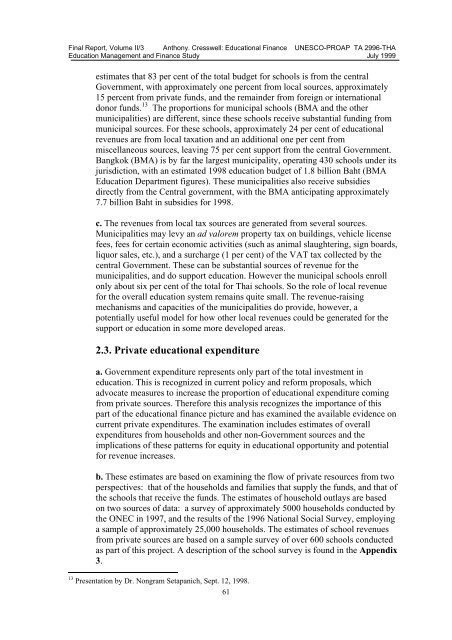Educational Finance in Thailand - UNESCO Bangkok
Educational Finance in Thailand - UNESCO Bangkok
Educational Finance in Thailand - UNESCO Bangkok
Create successful ePaper yourself
Turn your PDF publications into a flip-book with our unique Google optimized e-Paper software.
F<strong>in</strong>al Report, Volume II/3 Anthony. Cresswell: <strong>Educational</strong> <strong>F<strong>in</strong>ance</strong> <strong>UNESCO</strong>-PROAP TA 2996-THA<br />
Education Management and <strong>F<strong>in</strong>ance</strong> Study July 1999<br />
estimates that 83 per cent of the total budget for schools is from the central<br />
Government, with approximately one percent from local sources, approximately<br />
15 percent from private funds, and the rema<strong>in</strong>der from foreign or <strong>in</strong>ternational<br />
donor funds. 13 The proportions for municipal schools (BMA and the other<br />
municipalities) are different, s<strong>in</strong>ce these schools receive substantial fund<strong>in</strong>g from<br />
municipal sources. For these schools, approximately 24 per cent of educational<br />
revenues are from local taxation and an additional one per cent from<br />
miscellaneous sources, leav<strong>in</strong>g 75 per cent support from the central Government.<br />
<strong>Bangkok</strong> (BMA) is by far the largest municipality, operat<strong>in</strong>g 430 schools under its<br />
jurisdiction, with an estimated 1998 education budget of 1.8 billion Baht (BMA<br />
Education Department figures). These municipalities also receive subsidies<br />
directly from the Central government, with the BMA anticipat<strong>in</strong>g approximately<br />
7.7 billion Baht <strong>in</strong> subsidies for 1998.<br />
c. The revenues from local tax sources are generated from several sources.<br />
Municipalities may levy an ad valorem property tax on build<strong>in</strong>gs, vehicle license<br />
fees, fees for certa<strong>in</strong> economic activities (such as animal slaughter<strong>in</strong>g, sign boards,<br />
liquor sales, etc.), and a surcharge (1 per cent) of the VAT tax collected by the<br />
central Government. These can be substantial sources of revenue for the<br />
municipalities, and do support education. However the municipal schools enroll<br />
only about six per cent of the total for Thai schools. So the role of local revenue<br />
for the overall education system rema<strong>in</strong>s quite small. The revenue-rais<strong>in</strong>g<br />
mechanisms and capacities of the municipalities do provide, however, a<br />
potentially useful model for how other local revenues could be generated for the<br />
support or education <strong>in</strong> some more developed areas.<br />
2.3. Private educational expenditure<br />
a. Government expenditure represents only part of the total <strong>in</strong>vestment <strong>in</strong><br />
education. This is recognized <strong>in</strong> current policy and reform proposals, which<br />
advocate measures to <strong>in</strong>crease the proportion of educational expenditure com<strong>in</strong>g<br />
from private sources. Therefore this analysis recognizes the importance of this<br />
part of the educational f<strong>in</strong>ance picture and has exam<strong>in</strong>ed the available evidence on<br />
current private expenditures. The exam<strong>in</strong>ation <strong>in</strong>cludes estimates of overall<br />
expenditures from households and other non-Government sources and the<br />
implications of these patterns for equity <strong>in</strong> educational opportunity and potential<br />
for revenue <strong>in</strong>creases.<br />
b. These estimates are based on exam<strong>in</strong><strong>in</strong>g the flow of private resources from two<br />
perspectives: that of the households and families that supply the funds, and that of<br />
the schools that receive the funds. The estimates of household outlays are based<br />
on two sources of data: a survey of approximately 5000 households conducted by<br />
the ONEC <strong>in</strong> 1997, and the results of the 1996 National Social Survey, employ<strong>in</strong>g<br />
a sample of approximately 25,000 households. The estimates of school revenues<br />
from private sources are based on a sample survey of over 600 schools conducted<br />
as part of this project. A description of the school survey is found <strong>in</strong> the Appendix<br />
3.<br />
13 Presentation by Dr. Nongram Setapanich, Sept. 12, 1998.<br />
61

















